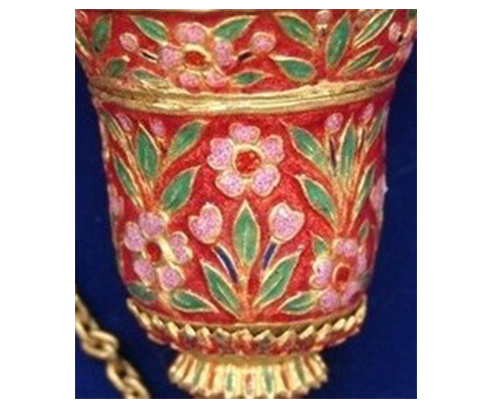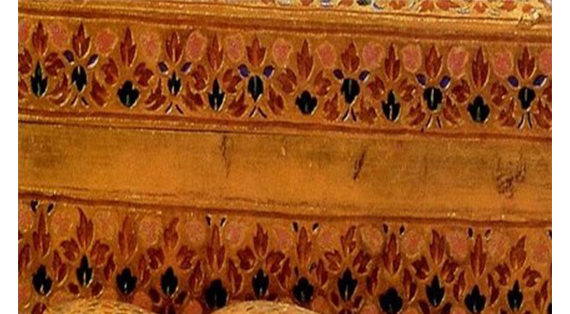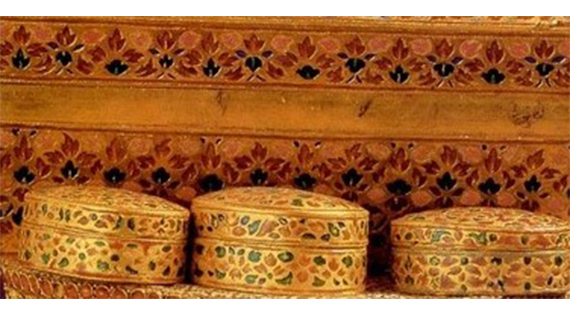The reign of King Chulachomklao or King Rama V of Rattanakosin (1868-1900) was the period in which the Kingdom of Siam was undergoing a tremendous change due to the cultural influx from the West. So was the Siamese court. Such influence was reflected in the bestowment of royal decorations instead of royal regalia as had been done in the past. Nowadays, the royal regalia are to be bestowed only to high-ranking royal family members on the occasion that they are promoted to a higher rank, and lent out to those who have received the royal decoration at Chulachomklao level to be photographed only. Due to this reason, the bestowment of royal utensils as royal regalia to Her Royal Highness Princess Sirindhorn on the occasion of a royal promotion on the king’s birthday on 5th December 1977 was extraordinary. The king has given a permission for this set of royal utensils to be exhibited for the public at the Hall of the Royal Regalia, the Royal Decorations, and the Royal Mint at the Royal Palace. According to records, this set of royal utensils was made during the reign of King Rama V, and has been bestowed to Queen Rumphi Phanni by King Rama VII. It is a unique set of enamelware due to its harmonious beauty of pink-coloured enamel, differnt from common kind of enamel wares where red and green colour are mainly used.
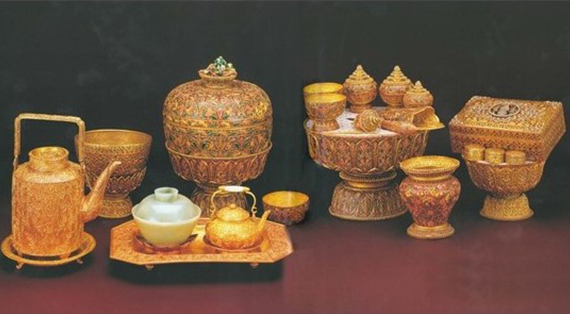
Pink Enamelware as the Royal Regalia of Her Royal Highness Princess Sirindhorn
The history of pink enamel
Pink-coloured enamel originated from the desire to ordain gold wares with colours instead of embedding them with jewelry. The latter technique, creating a bezel on a piece of gold ware to house a gemstone or a colourful stone, had been used since before Ayutthaya period. However, because gemstones were expensive and rare, as Ayutthaya began trading with Arabian and Persian people, the enamel technique was adopted instead. The earliest evidence was found in an underground repository at Wat Mahathat Temple, from the early Ayutthaya period. Early on, precious stones or semi-precious stones might have been used. Probably due to the higher price of the stones, there was a shift to using coloured glass. Such glass would be ground and melted with heat to decorate the surface into different patterns. This became enamelware. Red and green were popular colours in the early period. Later, white, navy blue, and light blue were used. The latter style is call Rachawadee style. It originated and became popular in Rattanakosin Period. Regarding pink enamel, the colour might have been created by mixing red enamel with white enamel. Pink enamel was usually found on gold wares that were made during the reign of King Rama V or those where Western influence was visible. Therefore, it is assumed that pink enamelware was popular in this period, and was used only within the royal court. There is also an assumption that the pink colour is the King’s favourite colour. Pink colour can be found generally on artworks that were created during the reign of King Rama V, and is the colour that represents Tuesday - the birthday of the King. Pink enamelware is considered to be the representative style of Rattanakosin gold ware that was created King Rama V’s period.
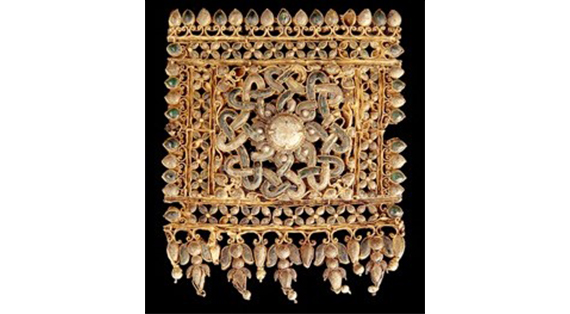
An ancient technique to house a gemstone or a colourful stone on a piece of gold ware
The significance of pink-enamelled royal utensils
The comparison between contemporary art pieces and old photographs shows that the pink-enamelled royal utensils were first made during King Rama V’s period. From then onwards, they were given as a decoration to the royals with the title Chao Fa and other high-ranking royal family members. The pink-coloured enamel not only tells a story regarding the king’s favourite colour or a story about the king himself, it also reflects the development of the making of gold ware in the Siamese court. It shows that Western influence was incorporated well into Thai craftsmanship, resulting in a very distinctive type of enamelled goldenware in Rama V’s period.
Types of pink-enamelled goldware within the set of the royal regalia belonging to Her Royal Highness Princess Sirindhorn
In this particular set of royal regalia which is on exhibition in the Hall of Royal Regalia, there are 27 items made of gold, among them, 14 pieces of pink-enamelled goldware as the following:
1. Pink-enamelled gold tray for betel nut set, one item.
2. Pink-enamelled small gold jar with a tapered lid, 3 items.
3. Pink-enamelled flat container for betel leaves, made of gold, 1 item.
4. Pink-enamelled small gold cup, 2 items.
5. Pink-enamelled small container with a tapered lid, made of gold 1 item.
6. Small knife with pink-enamelled gold shaft, 1 item.
7. Pink-enamelled lidded bowl, made of gold, 1 item.
8. Pink-enamelled tray for the water bowl, made of gold, 1 item.
9. Pink-enamelled floating gold cup, 1 item.
10. Pink-enamelled gold chest, with the royal coronet seal on top, 1 item.
11. Pink-enamelled spittoon made of gold, 1 item.
Designs of the pink enamel
There are three designs of pink-enamel that are found on this set of royal regalia:
Design 1 Botanical vines with trumpet flowers and pomegranate This design is a major design, found on several items in the set. The pattern is of floral vines in Western style, soft and delicate. One distinct characteristic of the pattern is the design of a long-petalled flower decorated with pink enamel, which is similar to the design on the commemorative Phodduang coins made during King Rama V’s reign. The design of the petals is long; the fruits are enamelled with green colour. There is a design of long and rambling stalks; while the background is enamelled with red colour. Such pattern must have been created for the royal wares that were used among the female court officials. The fruits that appear in the pattern bear strong resemblance of a pomegranate, which according to Chinese belief is considered auspicious. Lids of the container with this design were made to resemble the shape of an actual fruit, which represent the Western influence. With such characteristics, this design is called ‘Botanical vine with trumpet flowers and pomegranate’.

Botanical vines with trumpet flowers and pomegranate design
Design 2 floral and botanical vines This design appears on three items in this royal regalia set, including the knife, the small container with a tapered lid, and the spittoon. The design contains a drawing of floral vines and leaves in a vertical manner, including five-petalled flowers enamelled in pink, the pollens enamelled in red, leaves and stalks, which are long, enamelled in green, the pollen enamelled in pink. The pink flowers are said to be either trumpet flowers or the rose apple flowers. This design is considered one of the distinct characteristics of pink enamelled goldware, in other words, the representative of Rattanakosin art created during the reign of King Rama V. Drawings of a small fruit enamelled in Pink, resembling those found on the first design, can be found within the pattern. The fruit might be pomegranate, which has auspicious meaning. The background is enamelled in red which was the colour in fashion at that time.
Floral and botanical vines design
Design 3 Stalks and flowers with traditional Thai detail This pattern appears on the top side of the betel nut chest as well as the jars in the triple jar set. The design contains flowers with traditional details on the petals which are of trifoliate shape. The flowers are connected in a neat and tidy manner; their stalks are intertwined are connected. A special enamelling technique was used; the design was chiselled out in order to place red, green, pink, and blue enamel in an alternate order. The pink enamel found here is consistent with that on the seal of coronet on top of the betel nut chest.
Stalks and flowers with traditional Thai detail design
The technique of enamelling pink colour
There are two techniques used on the items in this royal regalia set:
1. Embossing This technique is traditional for enamelling gold ware. It is a process to produce raised designs on the other side. The lines of the design will be raised in order to hold the desired colours. Pink colour is used in main designs, for example, flower petals or fruit designs.
Embossing technique
2. Engraving This technique is found only on the enamelled gold ware of Rattanakosin era. It is a process of incising designs and put the desired colours onto those designs. The enamel is even with the background surface. The surface is plain, and no colourful enamel is used.
Engraving technique
The pink-enamelled gold ware within the set of the royal regalia belonging to Her Royal Highness Princess Sirindhorn that are on exhibition at the Hall of the Royal Regalia are an evidence of the development in techniques to create more colours to decorate gold ware. They also reflect the fascinating incorporation of foreign craftsmanship into Thai traditional craftsmanship, resulting in a character that is unique to the craftsmen of the period. Additionally, the fact that pink colour was royally favoured and used in royal art pieces during the King Rama V’s period makes pink-enamelled goldware the representative pieces of the period as well as the Rattanakosin era. Therefore, they are priceless and most worth as the regalia to decorate the high-ranking royals of Thailand from past to present.




